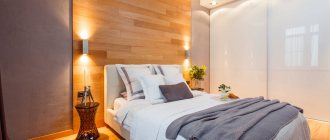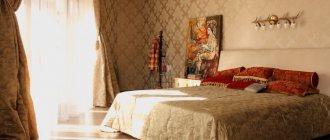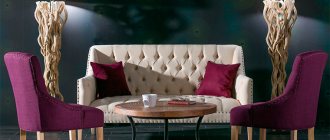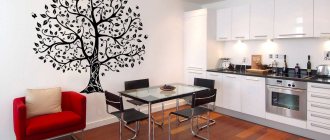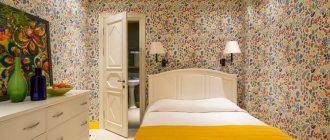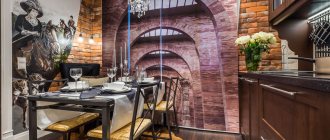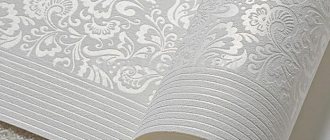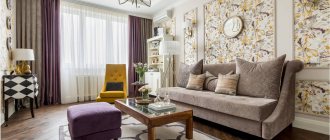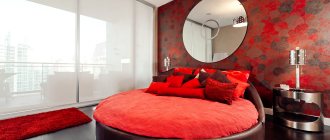From this article you will learn:
- What wallpapering options are popular today?
- What are the features of gluing two types of wallpaper?
- What material are wallpapers made of?
- What rules to follow when choosing wallpaper
- How to glue wallpaper correctly
- What's the best way to wallpaper a living room?
- What features to consider when wallpapering in the bedroom
Nowadays, most people in Moscow are trying to transform their apartment with the help of an original design. A large selection of finishing materials in construction supermarkets will help realize any ideas for creating a unique interior. Wallpaper has been the most versatile way to decorate rooms for many years.
Nowadays, wallpapers differ not only in color, but also in texture, relief, and the material from which they are made. With their help, you can easily zone the space, visually change the size of the room and implement the most daring design solutions. In our article we will tell you what options there are for wallpapering and which ones are best suited for a particular room.
What wallpapering options are popular today?
As you know, demand creates supply. Therefore, wallpaper manufacturers offer a wide range of products of various structures and designs. Moreover, many wallpapers have special shades and patterns, due to which you can easily combine different types with each other using a combined gluing option. Today, choosing wallpaper and the appropriate method of gluing is not difficult.
There are many ways of gluing and combinations of wallpaper. The most popular today are:
- A combination of two types of wallpaper of the same color, but different tones. In this way you can decorate one or more walls in the room. The most successful wallpapers for this gluing option are beige, gray and blue shades. To decorate a study in an apartment, wallpaper in strict colors is better suited.
- Combining wallpaper with a pattern or ornament with plain ones. A prerequisite for this will be a successful combination of colors. When making bold color decisions, it is better to consult with specialists. This option of wallpapering will make the interior more dynamic. This method is also used for zoning a room by emphasizing certain areas of the room.
- Using different types of wallpaper with patterns. In this case, it is also necessary to take into account the combination of shades. The most popular combination of wallpaper on which an ornament is applied, with wallpaper that has a geometric pattern or horizontal or vertical stripes.
To add originality to a room, a game of contrasts is often used, using wallpaper of different colors. By focusing on bright colors, they create zoning of the room. The options for wallpapering two types are more common among the younger generation, who prefer a modern design style and bright contrasting colors.
In addition to the color and combination of wallpaper, you should choose one of the many options for gluing it to the walls, taking into account the direction, number of types and other nuances.
- Nowadays, the technology of wallpapering a room horizontally is gaining popularity. To do this, the walls are divided parallel to the floor into two parts and covered with wallpaper of different colors and designs. Moreover, the width of the bottom strip of wallpaper should not be less than one meter. Often this method uses two types of wallpaper of the same color but different textures. The joints are decorated with special borders - paper, wood, plastic or PVC.
- Decorating a room with wallpaper using the vertical stripes technique looks original. With this option, strips of wallpaper of the same width and texture, but of different colors, are glued to the walls perpendicular to the floor.
This method allows you to realize the most unusual design ideas, since it allows the use of both plain and contrasting materials.
How to choose the right material to combine?
Sequence of wallpapering.
To choose the right material for combination, you should:
- compare shades and textures;
- choose the right combination;
- choose contrasting shades and patterns;
- make original connecting seams.
Combinations of wallpaper in different shades and textures followed by painting look beautiful. For such combinations, the material chosen is non-woven and fiberglass.
Silk-screen printing and materials with holographic threads never go out of fashion. These types of materials, combined with matte shades, create zoning for the walls in living rooms, giving them a luxurious look.
Related article: How to remove a window on a loggia with your own hands
Combinations of bamboo sheets, jute-based plant materials with paper wallpaper look beautiful. In this case, the decor gives the room harmony, comfort and a healthy microclimate.
Options for wallpapering two types
The choice of wallpaper is of great importance when decorating a room. Correctly selected wallpaper can transform almost any interior. You can correct an unsuccessful layout by gluing two types of wallpaper that differ in texture, color or pattern.
From a variety of wallpaper design options, you can choose the most suitable design, but you must take into account a whole list of conditions.
- Ceiling height.
It is this characteristic that will determine what type of pattern you need to choose for the wallpaper, as well as what color and texture it will be. With a standard ceiling height of 2.5 meters, it is recommended to choose wallpaper with a delicate texture, light shades, and without large patterns. Combining basic light wallpaper with others that have a subtle texture or pattern will help visually increase the space with a very low ceiling. Another option is to hang wallpaper with painted vertical stripes or wallpaper sheets of different colors alternating in height. This method is better to decorate two or three walls in a room, but this design of only one wall is possible.
The approach to choosing wallpaper for a room with a high ceiling (from 3 meters and above) is fundamentally different. In this case, it is better to prefer wallpaper with a large pattern, stretched in width. There are options for wallpapering using horizontal wall division technology. The classic technique uses different colors in the upper and lower half. Modern style involves a more careful selection of colors and patterns in the design of wallpaper.
- What are the dimensions of the room?
In addition to height, other room parameters should be taken into account. First of all, you should pay attention to the area of the room. A large room allows you to use wallpaper in rich or dark shades. With their help, you can visually reduce the size and give the room a more comfortable look. You can use dark-colored wallpaper with large light patterns - these can be floral motifs, abstractions or geometric patterns.
It is recommended to decorate small rooms with light-colored wallpaper. If desired, a faint texture or small pattern is allowed.
Secondly, you should take into account the geometric parameters of the room. If the room is very narrow, then gluing two types of wallpaper will help to visually adjust the length. The photo shows an ordinary room, the geometry of which was visually aligned by gluing lighter wallpaper on the short walls and part of the adjacent long walls.
If the entrance to a narrow room is located on the side of a long wall, you can highlight the central part of the opposite wall using wallpaper of a different color. At the same time, to decorate the corners of the room, the same wallpaper is used as on the walls of the short side. This technique will help to significantly change the perception of the room: it will no longer seem elongated.
- Choosing a texture.
Hanging two types of wallpaper in the bedroom or living room requires careful selection of the thickness and texture of the canvas. The choice of wallpaper panels of the same type is especially important if their joint is in the middle of the wall. Designers strongly recommend using mostly one type of wallpaper, otherwise the interior of the room will seem too exaggerated. Only if the joints of the canvases are at the corners of the room can an insignificant transition of wallpaper of different textures or thicknesses be allowed.
When gluing canvases that differ in texture, you should use the appropriate adhesive. Non-woven or paper-based wallpapers, vinyl-coated, acrylic or structured fabric wallpapers require special adhesives designed only for specific materials. As a last resort, you can use universal glue, the composition of which is suitable for most types of wallpaper.
- Dark or light room.
If the room is very bright or the interior looks a little monotonous, it is not at all necessary to cover all the walls with dark wallpaper. It is enough to decorate with dark canvases only one wall, which is located opposite the window, and the other three can be decorated in light colors. In this way, you can get rid of the oppressive atmosphere, the effect of which is usually produced by dark walls, but the room will no longer look too light.
Also, if the room is very dark, it is possible to use this technique. You can stick wallpaper in light shades only on the wall opposite the window, and the room will immediately become much lighter.
Preparing walls for gluing
How to hang wallpaper correctly so that the result does not disappoint? A good start is half the job: before gluing, you must carefully prepare the surface: it must be perfectly flat, white, free of debris and dust. The main rule is that you can’t glue wallpaper on crooked walls, and it’s better to invite specialists for leveling. Plaster is applied to uneven areas.
If the walls have oil or water-based paint or old wallpaper, you will have to work hard before gluing new ones.
Is it possible to glue new wallpaper onto old ones? Many experts advise against doing this. To remove the old paper covering, just use a wet roller or rag with a soapy solution. After 10-15 minutes, the paper will easily separate from the walls.
The process of removing old coating
As you can see in the photo, the old coating cannot always be completely removed. The residues are re-wetted and removed with a spatula.
If there is a waterproof film on the surface, it should be cut or scratched with a wire brush before wetting. When the surface swells, it’s time to clean it.
Removing old paint
Is it possible to glue wallpaper onto sanded and primed oil paint? Professionals do not advise doing this: there is a high probability of detachment. Oil paint can be removed mechanically or using special chemicals. The lagging paint is removed with a spatula, and then options are possible.
Removing paint with a hammer and chisel is a labor-intensive and time-consuming process, but relatively environmentally friendly. More often, a grinder with metal brushes or a hammer drill is used to remove old paint. The disadvantage of this method is a large amount of dust, which will settle for several days. Along with the paint, part of the concrete base is removed - as a result, the surface is littered with irregularities and has to be well puttyed.
Removers are used to remove only paint. Removing paint using special chemicals is carried out in two stages: the remover is applied to the surface, and then the softened paint is scraped off with a spatula.
It should be remembered that paint removers are very toxic, so work is carried out in a well-ventilated area, be sure to use a respirator and gloves.
To apply wallpaper to walls coated with water-based paint or whitewash, it will have to be carefully removed using water and a scraper. Hot water will make the task easier.
Wallpapering walls can begin only after complete removal of previous finishing materials, correction of uneven areas, finishing putty and sanding. The importance of these stages cannot be underestimated: proper preparation is the key to an excellent result.
When the walls are leveled, puttyed and sanded, all that remains is to apply a primer that will protect the coating from moisture, prevent sagging and reduce glue consumption. The primer is evenly distributed over the surface with a brush or roller about a day before wallpapering the wall.
Now let's look at how to combine two types of wallpaper.
In practice, several methods of gluing wallpaper of two types are most often used. To decorate one room, you can use a specific method in its pure form, or you can combine several techniques at a time. The main thing is to clearly imagine a detailed picture of the desired interior.
- Vertical combination.
It is well known that vertical stripes help to visually increase the height of the ceiling. However, stripes do not necessarily have to be present on all walls. Modern style involves many interpretations, for example, one wall can be covered with striped wallpaper, and the other three; simply paint it with plain paint or decorate it with wallpaper with a slightly noticeable pattern.
With the classic design option, vertical stripes are distributed over all walls. They can be placed at certain intervals around the entire perimeter or at different intervals on different walls.
Stripes may differ in color or pattern. It is recommended to combine wallpaper with the same texture, otherwise the design of the room will look awkward and sloppy. For the vertical option of wallpapering, canvases from the same collection are ideal. Manufacturers often produce a series of wallpapers whose designs combine well with each other. Typically, such a collection is presented in several colors, more often it is a couple of types of wallpaper with a plain background and the same number of options with an ornament or pattern.
Vertical combination allows you to use another interesting method, in which the ceiling appears much higher. To do this, one strip of wallpaper is placed on the ceiling, as if in continuation of the wall. This way the transition border becomes invisible and creates a feeling of additional free space.
Graphic images will help to clearly demonstrate the principle of strip distribution depending on the gluing option. The following pictures show a top view of rooms covered with wallpaper using a vertical combination.
These options are considered the most win-win. When using one of the presented schemes, vertical wallpapering of two types of wallpaper from one collection is guaranteed to be spectacular. Such wall design options have been tested in practice many times, and as a result the room always looks great.
- Horizontal division.
One of the classic design techniques that helps get rid of the so-called well effect. It is often used when decorating small rooms with high ceilings, as well as corridors and hallways. Dividing rooms horizontally has been used for many years, but nowadays the abundance of textures and colors of materials gives it a special look and originality. Most often, the room is divided horizontally by a narrow strip along the entire perimeter, focusing on the height of the window sills. In the classical design, the wall plane is divided into three parts, and the encircling strip is placed on the border of the lower or upper parts.
Modern style allows exceptions to the rules, and often a horizontal stripe is designed at eye level, and various decorative accessories are placed along it. It looks beautiful and original. As a rule, the lower part of the room is decorated in darker tones than the upper part, but you can experiment with colors.
Traditionally, when dividing a room horizontally, two types of wallpaper are used in the following combinations:
- top – 2/3 – plain wallpaper or with a small pattern, bottom – striped wallpaper;
- top - 2/3 - plain wallpaper or with large monograms, bottom - wallpaper with small patterns;
- top – 1/3 – plain wallpaper, bottom – wallpaper with a large pattern.
- Zoning.
This technique is used to highlight certain areas in one room using wallpaper of different colors. Studio apartments are often decorated in this way, highlighting individual functional areas with wallpaper: for example, a dining room and a relaxation area.
Zoning with wallpaper of several colors is often used when decorating a nursery. Here you can visually distinguish between a play area, a study area with a desk and a sleeping area. Zoning a children's room is also important if several children live in it. At the same time, it would be fair to take into account the wishes and interests of each child in the design.
When combined, these options for wallpapering a room allow the use of canvases with different textures to highlight functional areas. To prevent the transition from looking provocative, it is better to join different panels in the corners or separate them using moldings.
- Panels or decorative inserts.
For a long time, wallpaper of different colors was used to decorate one room, but previously they were made of fabric and decorated with special “frames”. Such materials had a high cost and were available exclusively to the upper classes. This is how it has been done since past years: wallpaper of two types was designed in the form of panels. Today, this option is used to create classic interiors; silk-screen printing, embossed or textured materials are used for insertion.
Some design styles (classic, Provence and country) allow you to decorate elements of a different color with a molding frame. This interior design looks quite stylish and original.
More modern styles (for example, modern) also use similar panels in their design. But then the frame can be made from a border of the same color, presented in the same collection, or cut out yourself from the wallpaper itself.
As an option, you can decorate a niche in the form of a panel. To do this, the design and texture are carefully selected, according to the general style and the main interior.
For these purposes, it is also optimal to use paintings from the same collection. Professional designers can easily select wallpaper based on their experience and intuition. Lovers can make a mistake when choosing the right wallpaper. To minimize the risks of an unsuccessful interior, it is better to take wallpaper from one collection.
- Color accents.
There are several principles for using such techniques. The first is when there is a need to divert attention from any elements that seem unsightly to you. So, some apartments may have uneven or even sloping walls. To prevent the presence of such interior imperfections from being noticeable, the opposite side is highlighted using wallpaper of a different color or with a different pattern. The main thing is that they can attract attention to themselves.
In the second case - when, on the contrary, there is a desire to pay attention to some interior items. In bedrooms there is usually a bed, sometimes a wall opposite it. Options for wallpapering in the kitchen will help shift attention to the dining table, diverting eyes from the place where food is actually being prepared. In this case, the color accent is partly an element of zoning.
Most often, attention is focused using a vertically directed strip of wallpaper, but there are other options for highlighting individual places. So, in a room with high ceilings, a wide horizontal strip or just some part of the wall can serve as an accent.
Some rooms have a niche or projections of a load-bearing wall. It is not at all necessary to mask such areas, as is often attempted. On the contrary, by focusing on such architectural elements using wallpaper of a different color, you can make them a kind of “highlight” of the room. This technique will give the room style and personality.
There are many ways to wallpaper different colors in one room. Considering all the above nuances, it will not be so difficult to choose your option that will suit you!
Wallpapering technology
Many apartment owners, when replacing the trellises themselves, believe that they know how to properly glue wallpaper. Indeed, they can stick simple single-layer paper wallpaper on the wall without any problems. However, when working with other types and types of wallpaper, questions begin to arise. So how to hang wallpaper yourself?
The technology of covering walls with modern wallpaper is not complicated and consists of several interrelated stages. It can be represented step by step as follows:
- the required amount of wallpaper is calculated;
- wallpaper and glue are purchased;
- the necessary tools and devices are prepared;
- select the location for gluing the first sheet of trellis;
- the pattern according to which the wallpaper should be glued is determined;
- wallpaper sheets are cut;
- the adhesive mass is prepared;
- the trellises are glued to the wall.
Materials and tools
For continuous and high-quality work, you will need materials and a set of tools with accessories.
Materials. To paste the walls you need to buy:
- wallpaper (non-woven, photo and glass wallpaper, paper, vinyl, etc.);
- wallpaper glue (preferably specialized).
Tools and accessories. You can apply wallpaper with a minimal set of tools. But in order for the job to be done quickly and beautifully, you need to have on hand:
- stepladder;
- plastic bucket - 2 pcs. (for glue and clean water);
- cuvette (bath) for glue;
- a roller 250 mm wide and a paint brush (brush for edging wallpaper and finishing corners) for applying adhesive;
- metal spatula for cutting wallpaper on the wall;
- plastic wallpaper spatula (wallpaper brush) for leveling thin wallpaper or trellises with a three-dimensional (relief) pattern;
- a plumb line or laser level to find the vertical;
- a ruler with a pencil for drawing a vertical starting line;
- construction knife (scissors) with replaceable blades for cutting wallpaper to length;
- roulette;
- rubber roller for pressing the wallpaper to the wall;
- rubber roller, narrow, cone-shaped, for smoothing seams (joints);
- foam sponge for removing glue from the front side of the wallpaper;
- napkin (towel) for hands;
- screwdriver for removing sockets and switches;
- electrical tape for working with electrical wires.
Buying wallpaper
When going to the store to buy wallpaper, you must strictly meet two conditions:
- buy the required number of tubes;
- purchase tubes of the same shade.
Calculation of material quantity
You can calculate the required amount of wallpaper in 2 ways.
1. The height of the wall surface to be pasted is measured (it may not coincide with the height of the ceiling due to the non-removable plinth and baguette). The length of the roll (10 m) is then divided by the measurement, resulting in the number of complete trellis panels in one roll.
After this, the length of all walls is measured, the measurement results are added up - the perimeter is obtained in meters. The resulting number is divided by the width of the wallpaper tube (0.53 m, 1.06 m) and the number of sheets in it. The measurements taken can be written by the formula:
T = P/L x H/K , where
- T - number of wallpaper tubes, pcs.
- P is the length of the perimeter of the walls, in m.
- L is the width of the wallpaper tube (0.53 m or 1.06 m).
- H - the height of the wall surface to be pasted (the length of the wallpaper sheet to be pasted).
- K is the length of the wallpaper roll (10 m, 15 m and 25 m).
Attention: professional finishers advise not to take into account windows and doors when calculating the amount of wallpaper to buy.
The result obtained must be rounded up and 1-2 tubes of wallpaper should be added to match the color, for unexpected defects and reserve (repair of trellis sheets damaged on the wall).
2. The length of the perimeter of the walls is measured, after which the required amount of wallpaper is taken from the prepared table below.
Attention! If the height of the pattern (rapport) is more than 0.6 cm, it is necessary to add 1 more roll of wallpaper for every 6 tubes to all calculations.
It already takes into account all the nuances of calculating the required amount of wallpaper, but without taking into account the adjustment of the pattern.
Wallpaper requirements
When producing wallpaper, machines are filled with paint for a specific batch. When refilling, the tonality may be disrupted. At the same time, at a retail outlet you may not be able to see the difference in shade, but on the wall it will be clearly visible.
Therefore, you need to buy trellises from the same production batch, the same production date and the same article number. You can view this data on the liner (label) that is wrapped around each tube of wallpaper, which is clearly visible in the photo. Practice shows that not everyone knows this, and many ignore it. The result is clearly visible on the walls - the different tones of the trellises are striking.
Label on a roll of wallpaper.
Wallpaper markings.
Buying glue
The adhesive mass is purchased according to the type of wallpaper purchased. The number of packs (containers) of wallpaper glue is easy to determine - the packaging indicates the consumption in rolls with a length of 10 m and a width of 0.53 m.
If the wallpaper has different sizes, the amount of consumption is adjusted. The number of packages is the result of dividing the total number of trellises purchased by the amount of consumption (in rolls).
Where to start gluing
All recommendations for choosing a place to start work on decorating walls with trellises state that it does not matter where you start gluing wallpaper in the room - you can start from any place you like: a door, window, corner or even from the middle of the wall (the main thing here is that the first piece should be glued strictly vertically). However, such advice is not entirely correct. Paper wallpaper, especially single-layer (simplex), should be glued away from the window, and in different directions - so the seams are not visible.
Determining the pasting scheme
Depending on the type of wallpaper, experts offer two pasting schemes. How to glue paper wallpaper is shown in the diagram. Here work starts from the window and proceeds in different directions.
Scheme for covering walls with paper wallpaper.
For other types of trellises, we can use both the option shown in the diagram and work in a circle, when the beginning and end meet. In this case, work can start from:
- windows (following long-standing traditions);
- doors - the frame serves as a guide (replaces the vertical line);
- angle - in this case, using a plumb line, a vertical line is drawn from which work will be carried out;
- a vertical line drawn on the wall in any randomly selected place.
Step-by-step instruction
You can wallpaper your walls yourself, without involving professionals. To do this, you must act strictly in accordance with the instructions.
- Using a plumb line, a pencil draws a vertical line on the wall from which work will begin.
- The height of the wall to be pasted is measured and the first sheet of wallpaper is cut to size. Experts advise non-professionals to make an allowance of 10 cm, although those with even minimal experience working with trellises cut them immediately to size.
- The remaining panels are cut, matching the pattern on the floor, and not on the wall, as some authors of works on this topic recommend. Tapestries without a pattern are simply cut to size.
- The glue is diluted according to the instructions printed on the package.
- The adhesive mass is applied to the wallpaper (on the wall in the case of non-woven wallpaper) with a roller or a special brush. The edges are coated with a brush. First, spread the first (any) half (a little more than half) and fold it in half. The fold should not be fixed. Then the other half is spread and also folded in half (the correct folding method is shown in the figure below).
Scheme of folding wallpaper coated with glue.
The folded wallpaper is kept in this state until the impregnation process is completed - the approximate time is given in the table below.
| Wallpaper type | Time for impregnation, min. |
| Paper | 5 |
| Double-layer paper: | |
| dense | 7-8 |
| very dense | 10 |
| Vinyl | 8-10 |
- The upper half of the wallpaper sheet is opened and pasted on the wall (the lower part remains folded all this time). You need to orient yourself not by the ceiling, but by the drawn vertical line (if the upper half is glued correctly, the second half will easily follow the drawn line).
Having attached the top part of the wallpaper sheet, proceed to the bottom.
Attention: if the wallpaper is cut with an overlap, a margin of 4-6 cm is left at the top of the wall.
The wallpaper is smoothed with a wallpaper roller (plastic spatula) from top to bottom, from the center to the edges (see photo).
Smoothing the wallpaper with a spatula.
- The second half of the panel is revealed and also glued to the wall.
- The overlaps at the top and bottom are cut with a knife using a metal spatula.
The wallpaper is cut with a knife.
- The second and subsequent sheets are glued in the same way, according to the accepted scheme.
The recommendations given are considered universal, but are subject to adjustment for a specific type and type of wallpaper. More detailed information can be found on our website, where each type of wallpaper is dedicated to a separate work.
How to make joints invisible
During the work process, it is important to ensure that the joint remains invisible. Errors occur for 3 reasons:
- the consistency of the glue is incorrect (more liquid than required), as a result of which in some places the edge of the wallpaper bubbles (falls behind);
- wallpaper, by its nature, stretches under the influence of moisture from the adhesive mass, and when dry, contracts, forming a visible butt seam;
- An error was made when aligning the wallpaper - the sheets were glued overlapping.
The problem is solved by rolling the joint with a special narrow wallpaper roller. If an error is discovered after the trellis has dried, the visible seam is painted over with special corrective paint.
The places where the pasting was done with an overlap using a metal ruler and a construction knife are cut in the middle 10 hours after completion of the work (the wallpaper has shrunk, but the glue has not completely dried and allows you to remove both the lower and upper pieces of the cut trellis).
How to hang wallpaper in corners correctly
There are several secrets here that allow you to get the job done quickly and efficiently.
- You cannot glue a whole sheet on a corner because of a possible violation of its geometry, as a result of which the vertical line at the second part of the wallpaper disappears.
- Wallpaper in the corners is always cut off. It is necessary to leave 2-3 cm on the second wall. The next sheet is glued to the left overlap strip. Then, using a knife with removable blades and a metal ruler, a continuous cut is made in the middle of the seam. Strips of wallpaper from both the bottom and top are removed, and the seam is rolled with a narrow roller. If you wish, you can even choose a picture.
- External corners are covered using a similar technology.
Pasting of internal corners.
How to glue near windows and doors
The greatest inconvenience when covering walls with wallpaper occurs when encountering obstacles. You can avoid troubles by following the technology of gluing trellises near doors and windows. You can glue the trellises near the doorway using the following algorithm:
- wallpaper is glued to the wall over the doorway;
- the pasted sheet is joined to the previous one;
- The wallpaper is pressed tightly against the wall with a roller;
- scissors make a diagonal cut of the wallpaper towards the upper corner of the door casing;
- the wallpaper is rolled tightly to the side and top trim;
- the strongly protruding part of the wallpaper is trimmed with scissors;
- Using a metal spatula, the left strip of wallpaper is placed under the casing.
Attention: if the platbands sit tightly on the wall and it is impossible to put wallpaper under them, trimming is done with a knife using a metal spatula.
Covering the doorway.
Gluing near a window is much easier - the wallpaper is glued to the wall using conventional technology. After they have completely dried, the unnecessary part of the trellis is cut off along the edge of the window with a knife.
Rules for choosing wallpaper
When choosing wallpaper with a pattern, you should pay attention to ensure that they fit well together in design:
When choosing wallpaper, you should also take into account such an important factor as the material on which it is made. Construction stores today offer a very large assortment, but the main types of wallpaper are the following:
- Paper.
The most budget option. In addition, paper wallpaper is an environmentally friendly material and has good breathability. There are many color options, with and without different patterns and designs. One of the disadvantages is the relatively short service life, since paper wallpaper wears out much faster than other types. In addition, when planning your next renovation, they are not so easy to remove from the wall.
- Vinyl.
The wallpaper is quite durable and does not wear out for a long time. If you want to change the design, you can easily paint them in a different color in the future. Vinyl wallpaper has an attractive appearance. An excellent option for uneven walls. The pasted areas always look smooth and neat.
- Non-woven.
This attractive look has appeared on the market relatively recently, but is already popular. Gluing non-woven wallpaper is not difficult - they allow air to pass through well and, due to the plastic base, do not require direct application of glue; you just need to treat the walls with it.
- Textile.
Such wallpaper can create a rather rich and luxurious interior. They are certainly good, but they are expensive and require constant additional care.
The choice of wallpaper color is no less important, since the overall atmosphere of the room and the mood of its inhabitants depend on it.
- Cool colors have a calming effect on people's nervous system. Therefore, for hot-tempered and impulsive people, it is better to use blue or green wallpaper in dark shades when decorating a room.
- Warm colors will appeal more to romantic people. An excellent option for them would be to wallpaper in pink, beige and orange shades. But the colors should not be too bright, otherwise it may cause irritation.
- Black, gray and brown tones are considered depressive; they are better suited for decorating or decorating small interior elements.
Recommended articles on this topic:
- Arrangement of a small apartment
- Stages of renovation in an apartment
- Turnkey cosmetic repairs
Gluing wallpaper
First of all, prepare a place where you will measure, cut and apply wallpaper with glue. This could be a clean section of the floor or a piece of oilcloth spread on the floor. Prepare your tools so that they are always at hand. Dissolve the glue according to the instructions. Place a stepladder. And begin.
- Unwind the roll and measure the fabric to the required length. Cut it with sharp scissors or a special sharp knife. Cut the wallpaper strictly horizontally, using a metal ruler for this. To avoid damaging the floor, place a large cutting board under the wallpaper where the cut is made.
- Carefully read the instructions that come with each roll. Some wallpapers require applying glue to the canvas, some to the surface of the wall, some to both the wall and the canvas. Spread the canvas on the floor or oilcloth and apply glue to it (if you are gluing paper or vinyl wallpaper)
- Let the wallpaper absorb the glue a little. Five to seven minutes will be enough. After this, carefully lift the wallpaper by the top edge and begin gluing
- Start gluing from the window. A window or other opening will be an excellent vertical reference. To align the wallpaper vertically, use a level. It is enough to level the first canvas, and glue the next ones, focusing on it
All types of wallpaper are always glued with the windows and doors closed. The room should be warm, about 20°C. Draft is the first enemy of fresh wallpaper. The glue dries very quickly in a draft, and in some places the wallpaper simply does not have time to stick.
- Carefully lift the canvas to the ceiling and glue it to the wall, pressing well. Carefully bring each subsequent canvas to the previous one (end-to-end or with a slight overlap, if the type of wallpaper allows it) and smooth it out. To smooth, use a soft spatula or a large dry cloth. Smooth from the middle of the canvas to its edges
- If air bubbles appear under the wallpaper, they need to be smoothed out by squeezing the air over the edges of the canvas. This must be done very carefully so as not to damage the wallpaper. If the air bubble cannot be squeezed out or there is a risk of tearing the wallpaper, pierce it with a needle and gently squeeze out the air
- Cover the corners with two sheets, connecting them slightly overlapping. If you paste a corner with one sheet, then with a high degree of probability folds will form in this corner or the wallpaper will completely fall away from the corner after drying.
- What to do with sockets and switches? First, turn off the electricity. Remove covers from all outlets and switches. After the canvas is pasted, carefully make a cross-shaped cut in the wallpaper at the place of the rosette. Bend the resulting corners and cut off the excess with sharp scissors.
After you have dealt with the sticking, close the room and try not to use it for at least a day. Under no circumstances open the windows or create drafts, otherwise after a short time your new wallpaper will peel off the wall with a nasty crunch.
Recommendations for wallpapering
- When gluing vertically, it is recommended to use wallpaper of the same type and the same thickness, so that, if possible, the joints are completely invisible and do not attract attention.
- When choosing wallpaper to combine, it is advisable to place them next to each other in order to objectively evaluate the combination.
- When choosing wallpaper with a pattern, you should take into account the characteristics of a particular room, since different patterns can visually change the parameters of the room, and not always in a positive way.
- When decorating a niche in a room, as noted earlier, you can use wallpaper of a different color or special decorated wallpaper.
Wallpaper in a modern style - photo
Read: DIY sofa pillows (100 photos)
Let's discuss this article together:
Click to cancel reply.
Options for wallpapering in the living room: tips and nuances
The design of this room deserves special attention, since it is often visited not only by household members, but also by guests. Therefore, they always try to create a unique interior in the hall that will give maximum comfort. As already noted, there are various options for wallpapering in the living room. Of these, it is necessary to choose exactly the one that will best meet the desires and interests of all family members.
The design of the hall, like any other room, has its own characteristics. In order for the future interior to meet all expectations, you must adhere to the following rules:
- You can visually increase the height of the ceiling using wallpaper with vertical stripes, and wallpaper with horizontally oriented patterns will help expand the space;
- for small living rooms you should not choose canvases with large patterns;
- a dark room with insufficient lighting requires wallpaper in light colors;
- When combining several types of wallpaper in a room, you need to take into account the direction of their style.
Let's consider the types of wallpaper for the hall.
Which wallpaper from the wide variety is best to choose for the hall? To design a stylish living room, you should choose non-woven wallpaper. They have a dense structure and a long service life, do not deform during use, help hide unevenness and other imperfections in the wall surface, and if desired, they can also be coated with paint.
The quality of vinyl wallpaper is not at all inferior to non-woven wallpaper. The fabric on this basis ideally masks the seams. Wallpaper can be easily cleaned or washed. But the real decoration of the interior in the hall can be textile wallpaper. The fabric will make the room elegant and original, giving it a special charm.
You can also decorate the living room walls with bamboo wallpaper. They are easy to use and do not require special care.
Designer tips for wallpapering the living room.
Options for gluing two types of wallpaper in the hall will help to identify functional areas. Areas are highlighted using canvases of different textures and colors or companion wallpaper.
You can make the main design with plain embossed wallpaper, and cover one wall with canvases with bright patterns or stripes.
Another original interior option involves highlighting strips of plaster or polyurethane on one of the walls. At the same time, individual areas are covered with contrasting wallpaper, due to which the living room looks quite stylish.
Options for wallpapering in the bedroom
Today, manufacturing companies offer a wide selection of wallpapers of various textures and colors, so it is very difficult to give preference to any one option. To decorate a bedroom, smooth or textured wallpaper is mainly used.
Paper wallpapers are especially popular. Their cost is an order of magnitude lower than other types of wallpaper, and the choice of colors is simply huge.
Before choosing wallpaper in a store, you should carefully study information about their types, properties, advantages and disadvantages, and view all possible finishing options. The process of wallpapering is quite labor-intensive and time-consuming. Therefore, it is better to prepare and decide in advance what style of interior you will adhere to.
Wallpapering a small bedroom
It is very important to choose the right wallpaper color for finishing the bedroom, because not only the interior of the room, but also the mood of the residents, as well as the health of their sleep will depend on this. The choice of wallpaper color for the bedroom is influenced by many factors, but mainly you should start from your own preferences.
When choosing a color for a bedroom, you must take into account its parameters and the degree of natural light in order to visually adjust the space.
Healthy sleep depends on the energy that certain colors carry. Wallpaper in a soft blue color will help you relax and unwind mentally. Decorating the bedroom in dark blue will make moments of relaxation pleasant and promote sound sleep.
What other color to choose:
- Green, which also promotes relaxation and will allow you to have a good rest after intense intellectual work.
- Metal, which will give a pleasant coolness to the room if its windows face the sunny side. Metallic wallpaper will cool the bedroom on a hot summer day.
- Brown and beige, which will help create comfort and coziness, will give a warm and calm atmosphere.
Wallpaper in light shades will help visually increase the space in a small room. In a bedroom with a small area, it is better to avoid black wallpaper and wallpaper with large patterns. When choosing wallpaper, you should also take care of combining it with lighting fixtures.
Wallpapering a bedroom with furniture of different styles
In order for the interior of the room to look advantageous, the wallpaper must have a suitable color and appropriate texture, and at the same time successfully harmonize with the furniture and other interior items. In most cases, wallpaper provides only a background for the interior decor.
Of course, wallpaper is of great importance in the design of a room, but it is not enough just to choose the right color and texture. It is important that they are neutral, without flashy colors, because the bedroom primarily acts as a place for relaxation and sleep. It is better to plan the choice of wallpaper last, when the final design style has already been determined and the appropriate furniture has been purchased.
Combination options:
- For dark-colored furniture, you should choose wallpaper in warm and light colors.
- For light-colored furniture, you need to choose wallpaper in light or muted shades.
At the discretion of the owners, you can either combine the colors of wallpaper and furniture, or play up their contrast. The second option will look good only in a large spacious room.
There are many design and construction portals on the Internet where you can get acquainted with all kinds of interior options and design projects. Using their example, you can clearly imagine the design of your future bedroom and build on this option when choosing materials for decoration.

